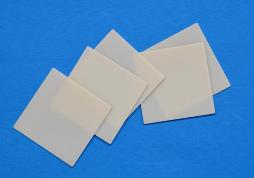As a new ceramic material with excellent comprehensive performance, aluminum nitride (AlN) is a hexagonal crystal, pure AlN is blue-white, usually gray or off-white. Aluminum nitride ceramics have excellent thermal conductivity, reliable electrical insulation, low dielectric constant and dielectric loss, non-toxic and thermal expansion coefficient matching silicon, etc. Excellent characteristics, considered to be an ideal material for a new generation of highly integrated semiconductor substrates and electronic device packaging.
1. AlN as substrate material
Most ceramics are materials with extremely strong ionic or covalent bonds and have excellent comprehensive properties. They have commonly used substrate materials in electronic packaging. They have high insulation properties and excellent high-frequency characteristics. At the same time, the coefficient of linear expansion and electronic components are very similar, the chemical properties are very stable and the thermal conductivity is high. From 1985 to 1988, the application of aluminum nitride in microelectronic encapsulation materials emerged. In the past, alumina and beryllium oxide ceramics have been used as substrate materials for most high-power hybrid integrated circuits for a long time, but the basic thermal conductivity of alumina is low, and the thermal expansion coefficient is not very matched with silicon. Although beryllium oxide has excellent overall performance, Its high production cost and high toxicity limit its application and promotion. Therefore, considering factors such as performance, cost, and environmental protection, the two can no longer fully meet the development needs of modern electronic power devices.
2. AlN as electronic film material
Electronic thin film materials are the foundation of microelectronic technology and optoelectronic technology, so the research on various new electronic thin film materials has become a hot spot for many scientific researchers. Aluminum nitride was discovered in the 1860s as an electronic thin-film material and has a wide range of applications. In recent years, wide-gap semiconductor materials and electronic devices represented by group IIIA nitrides have developed rapidly, and are known as the third generation following the first generation semiconductors represented by Si and the second generation semiconductors represented by GaAs semiconductor. AlN, as a typical IIIA nitride, has attracted more and more attention from domestic and foreign researchers.

3. AlN as a coating of the crucible or refractory material
The corrosion resistance of aluminum nitride can be infiltrated by molten aluminum but cannot react with it. Compound alloys including copper, lithium, uranium, iron and some super heat-resistant alloys; Many molten salts such as eutectic mixture, chloride and cryolite are stable. So it can be made into the crucible or refractory coating.
Aluminum nitride can be used as a container for vacuum evaporation and metal smelting. It is especially suitable for the vacuum evaporation of Al crucibles. Although AlN is heated in a vacuum, although the vapor pressure is low, it will not contaminate aluminum even if it is decomposed. AlN can also be used as a thermocouple protective sleeve, and it will not be damaged by continuous immersion in an aluminum bath at 800~1000℃ in the air for more than 3000h. In the semiconductor industry, using AlN crucibles instead of quartz crucibles to synthesize gallium arsenide can completely eliminate the pollution of Si on gallium arsenide and obtain high-purity products.
The multiple excellent properties of aluminum nitride determine its many applications. As a piezoelectric film, it has been widely used; as a packaging, dielectric isolation and winding material for electronic devices and integrated circuits, it has important application prospects; as blue light, Ultraviolet luminescent materials are also the current research hotspots; as high polymer materials, they can be used to fix molds, make adhesives, thermal greases, and heat dissipation pads… After further market development, the application range of aluminum nitride ceramic materials will be More and more widely.


